1860-1868 Chapter V STRUGGLE FOR THE MISSISSIPPI VALLEY
PERIOD IV.
CIVIL WAR AND RECONSTRUCTION
(Continued)
CHAPTER V.
THE STRUGGLE FOR THE MISSISSIPPI VALLEY
The North conducted the war upon three great lines of campaign: 1. The Western campaigns, to clear the Mississippi River and thus divide the Confederacy. 2. The campaigns in the centre, to reach the sea at Mobile, Savannah, or Charleston, cutting the Confederacy a second time. 3. The Eastern campaigns, to take Richmond, and capture or destroy the main Confederate army, ending the Confederacy. This chapter deals with the Western campaigns alone.
The opening of 1862 found the Confederates in possession of a strong line across the southern portion of Western Kentucky, stretching from Bowling Green, near the centre of the State, to Columbus on the Mississippi.
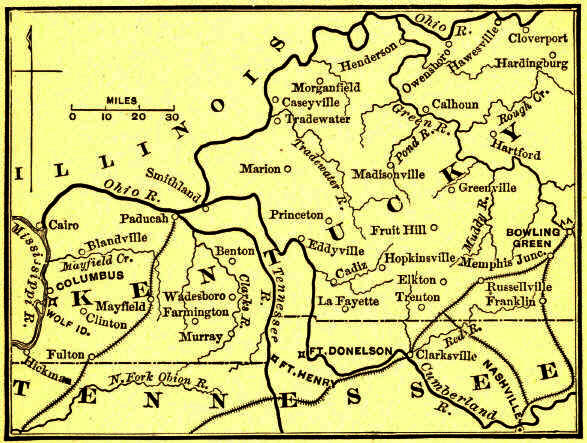
The Confederate Line from Columbus to Bowling Green.
The two gates of this line were Forts Henry and Donelson, on the Tennessee and Cumberland Rivers, respectively, just over the Tennessee border. If these forts could be taken the Confederates must give up Kentucky.
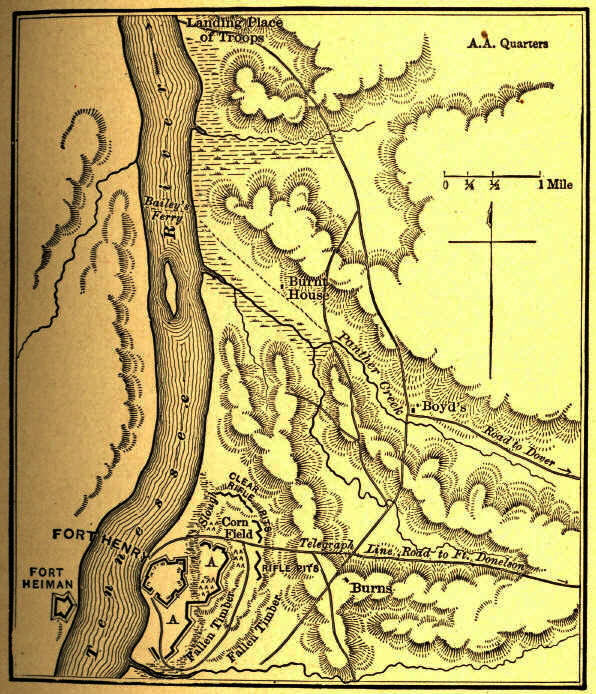
Fort Henry.
On February 6th, after a two hours' bombardment, Fort Henry surrendered to General Grant, who had come up the river from Cairo with 17,000 troops, and with seven gunboats commanded by Commodore Foote. Most of the garrison, about 3,000, had been sent off before the fleet opened fire, General Tilghman foreseeing that he could not hold the fort. The land forces arrived too late to cut off their retreat, and they escaped safely to Fort Donelson, some dozen miles to the east.
Grant marched at once to invest Donelson, and sat down before it on the 12th with 15,000 men. The stronghold stood upon a bluff 100 feet high. On the east it was protected by the Cumberland River; on the north and south by two flooded creeks. Along a crest back of the fort a mile or two ran a semicircular line of rifle-pits, with abatis in front. Nine batteries were posted at various points along the line. Donelson was garrisoned by 20,000 men under Generals Floyd, Pillow, and Buckner, who quietly looked on while Grant's smaller army hemmed them in. On the 14th the gunboats opened fire upon the water batteries between fort and river. Commodore Foote steamed up boldly within 400 yards and pounded the opposing works with his heavy guns.
He did little damage, however, while the Confederate fire proved very effective against him. His flag-ship, the Hartford, was struck fifty-nine times. A shot crashed into the pilothouse, destroying the wheel and wounding Foote himself. The boat became unmanageable and drifted down-stream. A shot cut the tiller-ropes of the Louisville. The other boats were also considerably damaged, and after an action of an hour and a half, the entire fleet withdrew.
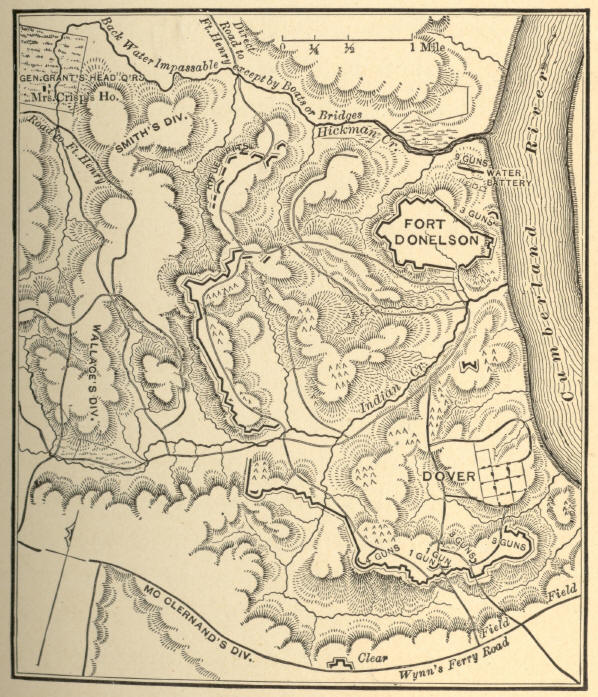
Fort Donelson.
But Grant's army had been re-enforced to 27,000. Three divisions, under Smith, Wallace, and McClernand, stretched in a semicircle about Donelson from north to south. On the night of the 14th the Confederate generals held a consultation, and decided to try cutting their way out. Most of the troops were withdrawn from the rifle-pits during the night, and massed on the Union right. The weather had suddenly turned frosty, and the Union men, without tents or camp-fires, many even without blankets, shivered all night in the intense cold. Before dawn the attacking column from inside, 10,000 strong, rushed through the woods and fell upon McClernand's division, which formed the Union right. For hours the woods rang with musketry and the southern yell. Slowly the Confederates drove the Unionists before them and gained the road running south to Charlotte, opening to themselves the way of escape.
This, however, they had not yet utilized, when, about one o'clock, General Grant, who had been aboard the fleet consulting with Commodore Foote, came upon the field. Learning that the foe had begun to fight with full haversacks, he instantly divined that they were trying to make their escape, and inferred that their forces had been mostly withdrawn from opposite the Union left to make this attack against the right. General Smith was therefore instantly ordered to fall upon the Confederate right. As Grant had surmised, the intrenchments there were easily carried. Meanwhile the demoralized soldiers of the Union right and centre rallied, and drove the Confederates back to their intrenchments. At daybreak Buckner sent to Grant for terms of capitulation. "No terms except unconditional and immediate surrender can be accepted: I propose to move immediately upon your works," was the answer. The resolute words rang through the North, carrying big hope in their remotest echo. Donelson surrendered. Floyd and Pillow had sneaked away during the night, the former monopolizing the few boats to transport his own brigade. Fifteen thousand troops remained and were taken prisoners.
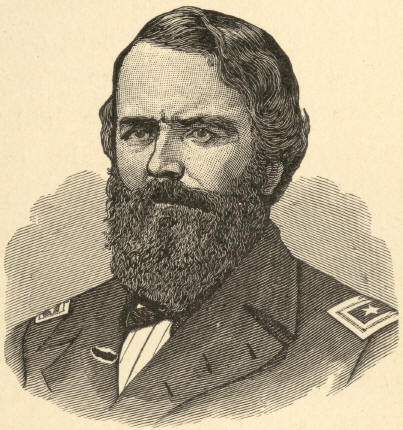
General John Pope.
The capture of Henry and Donelson necessitated the evacuation of Bowling Green and Columbus. Kentucky was now clear of Confederates, and the Mississippi open down to Island Number Ten. This island lay in a bend of the river at the extreme northwestern corner of Tennessee. The great stream here runs northwest for a dozen miles, then sharply turns to the south again. New Madrid stands at this northern bend. It was protected by Confederate fortifications and gunboats. Early in March, General Halleck, now at the head of the Western Department, sent General Pope against New Madrid with 20,000 men. The enemy fled to Island Number Ten, leaving thirty-three guns, besides ammunition and many tents.
Island Number Ten was strongly fortified. Commodore Foote came down the river with seventeen gunboats, and on March 16th began a bombardment which was kept up for three weeks with little effect; but early in April Pope got upon the Tennessee shore, in the undefended rear of the island, and by intercepting its communication to the south, forced it to surrender, April 8th. Seven thousand prisoners, one hundred heavy siege guns, several thousand small arms, besides large stores of ammunition and supplies, were thus secured, without the loss of a single Union soldier. This exploit brought to Pope great fame.
Pope now descended the river to Fort Pillow, 100 miles below, which he prepared to take. He was just then transferred by Halleck to another field, and the reduction of Pillow left to the gunboats. Pillow was abandoned June 4th. The Union flotilla, increased by four rams, now ran down the river to Memphis, where, on June 6th, in the presence of thousands of spectators upon the bluffs, it fought a battle with a southern fleet. Seven of the Confederate boats were destroyed, and the next day Memphis surrendered.
After the fall of Donelson the Confederates began concentrating their forces at Corinth, in the northeast corner of Mississippi. Meanwhile the Army of the Tennessee, under orders from Halleck, had moved up the Tennessee River, and encamped, some 40,000 strong, at Pittsburg Landing on the Tennessee River, 25 miles north of Corinth.
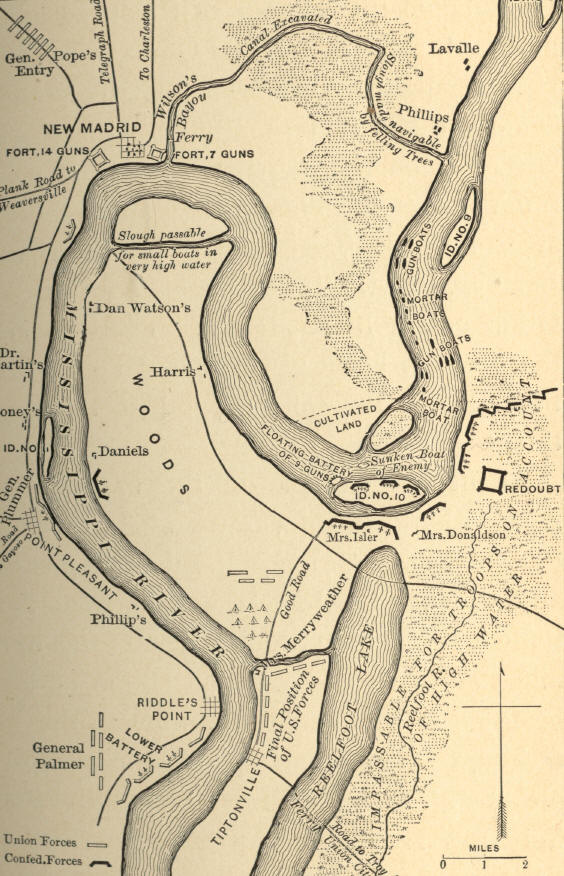

New Madrid and Island Number Ten.
Here Grant, who had been temporarily removed, took command again on March 17th. Buell, with 40,000 men, was on the march thither from Central Tennessee. The Confederate generals at Corinth, Albert Sidney Johnston and Beauregard, wisely determined to strike Grant before Buell arrived. There ensued the greatest battle which had up to that time shaken the solid ground of this continent.
[footnote: Indifferently called the battle of Shiloh or the battle of Pittsburg Landing.]
About six o'clock on the morning of April 6th the Confederates burst through the thick woods upon the Union pickets and drove them in. It was at least partially a surprise. Grant in person was nine miles down the river. The Union officers hastily got their men into line, as the attacking columns came sweeping in after the pickets. Three of the five Union divisions were raw recruits, many of whom fled at the first fire. Some colonels led their entire regiments off the field. Later in the day Grant saw 4,000 or 5,000 of these runaways cowering under the shelter of the bluffs.
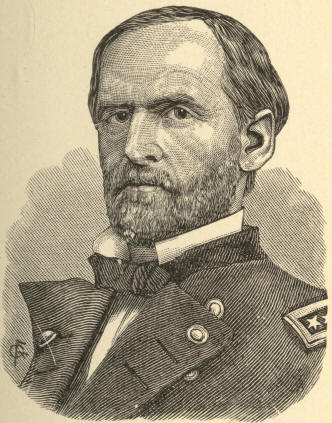
General William T. Sherman.
But the bulk of the army made a stubborn resistance. General W. T. Sherman, then comparatively unknown, inspired his division of raw troops with his own intelligent courage. Their gallant and protracted fight around the Shiloh log church made them the heroes of the day. But the Confederates' onset was impetuous. Step by step they forced their opponents back through the heavy woods, and by noon stood in possession of the Union camps; Grant's army, badly shattered, being cooped up in a narrow space along the edge of the river.
The tide now turned. About two o'clock, General Johnston was killed, and the Confederate advance flagged. Between the two armies lay a deep ravine. Grant planted some fifty guns upon the edge, and two of the gunboats took positions where they could rake the ravine. By these dispositions Beauregard's advance was stayed. Night fell, and hostilities ceased.
Fortunately, 22,000 of Buell's men arrived during the night, and next morning Grant ordered an advance. Beauregard made as desperate a resistance as he could, seeing that his heavy losses the day before had left him but 30,000 troops fit for duty.
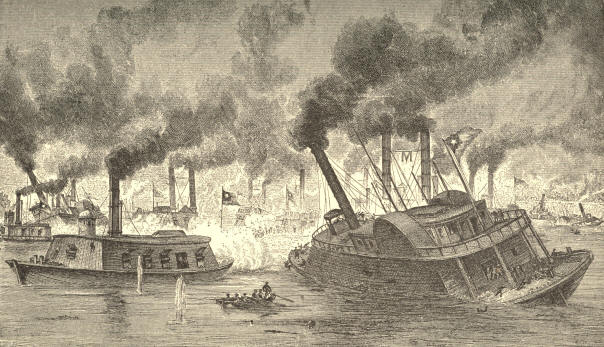
A.R. Ward H.R. Hall, JR.
The Battle of the Rams at Memphis, June 6, 1862
Buell's men showed the effects of long training under that matchless disciplinarian, and fought splendidly. The enemy were steadily pushed back, until more than all the ground lost on the preceding day had been triumphantly regained, and the battle of Pittsburg Landing, from being for the Union side a defeat accomplished and a surrender threatened, was turned into a bright and inspiring victory. Beauregard ordered a retreat, and, not being pursued, regained his old position at Corinth. He had lost about 10,000 men. Our loss was 12,000, including four regiments taken prisoners. The battle was a severe check to both sides.
On February 2d the largest fleet that had ever sailed under the American flag left Fortress Monroe for the mouth of the Mississippi, commanded by Commodore Farragut. It consisted of 16 gunboats, 21 mortar-schooners, six sloops of war, and five other vessels. Fifteen thousand land troops, under General Butler, soon followed. Thirty miles below New Orleans Forts Jackson and St. Philip, mounting 100 guns, frowned at each other across the Mississippi. Farragut's fleet sailed up the river and the mortar-schooners were moored to the banks within range of the forts.
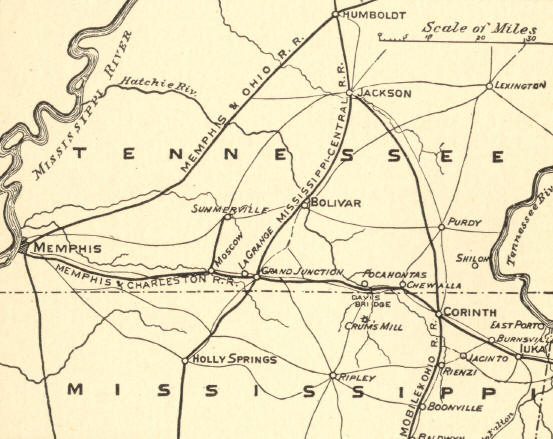
Memphis to Iuka. 1862.
Boughs were tied to the top-masts so that the enemy could not distinguish them from the trees along the shore. April 18th the mortars began shelling the forts. An incessant fire was kept up night and day, for six days, till nearly 6,000 shells had been thrown.
As the forts sustained little damage, Farragut decided to run the batteries. A gunboat stole up by night and cut the boom of hulks chained together, which crossed the river just below the forts. Some of the boats were rubbed over with mud to make them invisible, and chain cables hung over the sides to protect the engines. About half past two in the night of April 23d the fleet moved up the river through the gap in the boom. The enemy, on the alert, launched fire-rafts and lit bonfires to lift the cover of night. Old Jackson and St. Philip poured a hot fire into the fleet as vessel after vessel slowly steamed past, answering with its most spiteful broadsides.
But the Union craft had more than the forts against them. Once past the boom they were in the midst of a hostile fleet of fifteen vessels, including a dangerous ironclad ram. A fierce water-fight followed. The Union Varuna was sunk; the flag-ship Hartford set on fire by one of the fire-rafts. The flames, however, were soon put out. Other vessels were disabled. But every one of the Confederate ships was captured or destroyed, and Jackson and St. Philip had to surrender. Farragut then sailed up the river and took possession of New Orleans without resistance. Butler at once occupied the city with his troops, and the Stars and Stripes again waved over the Crescent City. Since that eventful day New Orleans has never been in disunionist hands.
After the battle of Pittsburg Landing, Halleck himself came down from St. Louis, and took the reins. Grant was nominally in command under him, but had next to nothing to do. Re-enforced by 25,000 men under Pope, Halleck slowly advanced toward Corinth, entering the place May 30th, Beauregard having evacuated it May 29th. A few Quaker guns--logs mounted on wagon-wheels--were the only trophies. Halleck now had 110,000 effectives, Beauregard less than 60,000. Halleck lay inactive at Corinth for six weeks, when he was summoned to Washington as General-in-Chief.
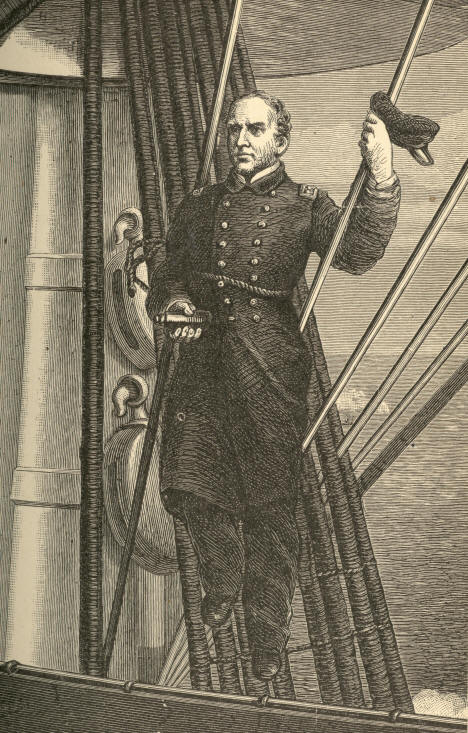
Farragut in the Main-Rigging.
From the original by William Page.
Grant once more took command of the forces about Corinth, which re-enforcements to Eastern Tennessee soon reduced to 42,000. With these he was expected to guard 200 miles of railroad, from Memphis to Decatur in Northern Alabama. The Confederates under Van Dorn and Price attempted to regain Corinth, but in the battles of Iuka, September 19th, and Corinth, October 3d and 4th, were repulsed with heavy losses. Grant then took the offensive. Vicksburg, about half-way from north to south on Mississippi's western boundary, was the only stronghold left to the Confederates on the great river. Its capture would ideally complete the western campaign. Grant's plan was for Sherman to descend the river from Memphis, while he himself simultaneously attacked Vicksburg by land.
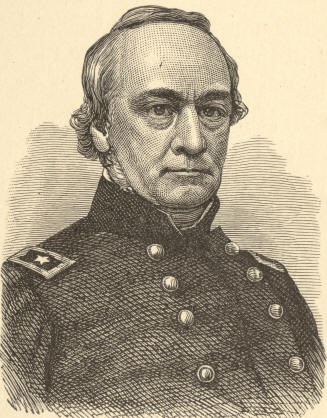
General Henry W. Halleck.
So long as the stout-hearted general continued his march south all his supplies had to be brought over the Mississippi Central Railroad from Holly Springs, near the Tennessee border. A troop of 3,500 Confederate cavalry, making a long detour around his army, swooped down upon Holly Springs, December 20th, captured the garrison of 1,300 men, and destroyed all the stores, valued at $2,000,000. For two weeks the Union army had to live from the enemy's country, and then after all to fall back to Holly Springs. Meanwhile Sherman, ignorant of his superior's ill fortune, descended the Mississippi, and with a force of 30,000 made during the last days of the year an unsuccessful attack upon Vicksburg.
Very early in January, 1863, McClernand arrived near Vicksburg with re-enforcements. The last of the month, Grant, who had given up the land expedition, took command in person. Sherman's repulse had shown that Vicksburg could not be taken from the water side. A position must be gained in the rear. This seemed, and indeed proved, an almost impossible task. The Mississippi was unusually high, and the surrounding country a vast network of bayous and swamps. The winter passed away in fruitless labors to make some sort of a water passage to the rear of Vicksburg, either above, via the Yazoo, or around through Louisiana to some point below the city, whence the army could cross again to the Vicksburg side of the Mississippi and strike Pemberton's stronghold from the southeast.
In most of these attempts Grant himself had little faith, but the army was better at work than idle. At last he resolved, without attempting a regular canal, partly by land but utilizing bayous and creeks as he could, to swing his army across west of the river to New Carthage, south of Vicksburg, run the Vicksburg batteries with the fleet, and, uniting his land and water forces in the capture of Grand Gulf, to gain the rear of Vicksburg by way of the Big Black River. It was a bold plan, but it succeeded.
In April, by building corduroy roads through miles of swamp and bridging numberless bayous, the general succeeded in reaching New Carthage, some twenty miles south of Vicksburg, with a good part of his land forces. On the night of April 16th, the gunboats and provision transports ran the gauntlet of Vicksburg's guns with little damage. The last of the month a landing was effected just below Grand Gulf, on the east bank, fifteen or twenty miles still farther south of Vicksburg. The enemy made some resistance, but were driven back.
Grant's position was now full of peril. He was in the heart of the enemy's country. Pemberton was occupying Jackson and Vicksburg with 50,000 men. General Joseph E. Johnston was hurrying to his aid with re-enforcements. Grant's forces available for an advance about equalled Pemberton's. A bold policy was the only safe one. Taking five days' rations, he cut loose from his base at Grand Gulf and marched north to attack Pemberton before Johnston could join him. Jackson, forty-four miles to the east of Vicksburg, was easily captured, May 14th. Grant had thus thrust himself in between Johnston and Pemberton. Turning to the left he smote Pemberton a heavy blow at Champion's Hill on the 16th, and drove him into Vicksburg. Johnston fell back baffled. In eighteen days Grant had marched 200 miles, defeated the enemy in four engagements, inflicting a loss of 8,000 and taking 88 guns, and shut up a large army in Vicksburg--all this upon five days' rations. It is a brilliant record, equalled, if at all, only by some of Napoleon's campaigns.
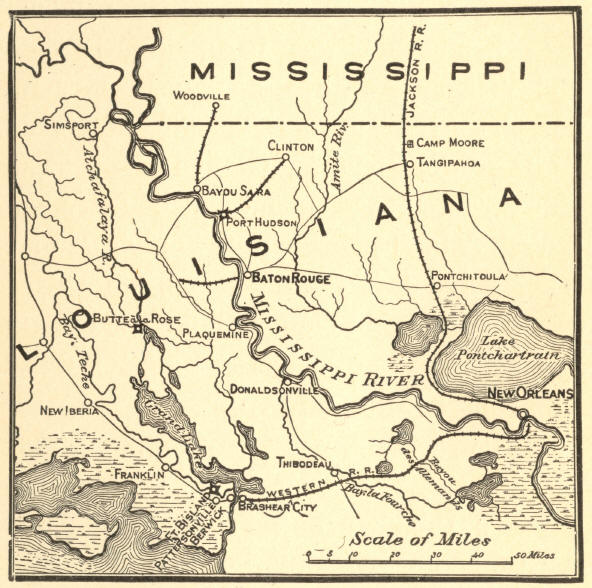
Operations in Louisiana. February to July, 1863.
The bold commander now transferred his base of supplies to the Yazoo River, which runs into the Mississippi a few miles above Vicksburg. After an unsuccessful assault upon the city's strong intrenchments, he sat down to a deliberate siege. Twelve miles of trenches were constructed. Eighty-nine batteries, with more than 200 guns, day after day rained shot and shell against the Vicksburg fortifications. The lines of investment crept nearer and nearer the fated city. The pickets chaffed with each other, and exchanged tobacco and newspapers. June 25th, a mine was exploded under one of the Vicksburg parapets, but it made no effectual breach. A second explosion, July 1st, was equally unavailing. Johnston kept menacing the rear, but feared to attack, as Grant had been re-enforced to 60,000.
Famine began to threaten the city, Porter's fleet blockading the water front. Flour sold for $1,000 a barrel in Confederate money. Mule flesh became the chief meat. Rats were hung up for sale in the market. The inhabitants sought protection from the shells in cellars and caves. Cave-digging became a regular business. The Vicksburg daily news sheet was now printed on wall paper. July 3d. white flags appeared upon the city's works.
46 CIVIL WAR AND RECONSTRUCTION
An armistice followed, and the next day Pemberton surrendered. The prisoners, some 30,000 in number, were mostly released on parole. With the fall of Vicksburg the western campaigns virtually closed. The capture of Port Hudson, below, was assured from that moment, and followed on July 8th. The "Father of Waters" once more rolled "unvexed to the sea," and the Confederacy was cut in twain.


